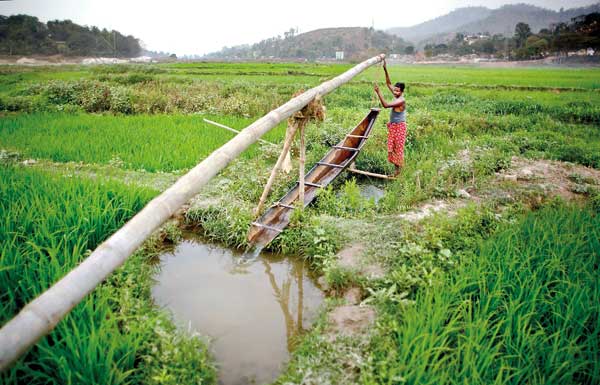05 Feb 2016 - {{hitsCtrl.values.hits}}

By R. Quentin Grafton and John Williams and Qiang Jiang
Asia’s food systems are under an unprecedented confluence of pressures. Balancing future food demand and supply in ways that protect the most vulnerable, while also being sustainable, must be a first order policy priority.
Demand for food is driven by population and income growth and also urbanisation. Global population size is projected to increase from over 7.3 billion today to more than 9.5 billion by 2050 under a medium growth scenario. Per capita income growth at 3 percent a year, will more than double average world income by 2050. More people and higher average incomes will result in greater food consumption and changes in diets.
For instance, rapid growth in per-capita income over the past two decades in China has been accompanied by sharp growth in the consumption of livestock products. Intensive livestock production is much less efficient than direct crop consumption in providing food calories. As meat contributes to a greater share of the calories consumed, proportionally more crops will need to be grown.
Recent studies estimate food production will need to increase by at least 60 percent between 2005 and 2050. Not only are there about 800 million people in the world chronically undernourished today, global studies show that it is necessary to increase global crop yield by a minimum of 1.1 percent per annum to feed the world by 2050. The current growth of average global crop yields varies between 0.9 and 1.6 percent per year. The future challenge is whether crop yield increases on the lower end of this range will be sufficient to meet increased food demands. Prospects for the future are all the more uncertain because past production has sometimes degraded or destroyed ecosystems on which agriculture is ultimately dependent. The availability of suitable lands for agriculture is likely to be plentiful in only a few regions by 2050. To make matters worse, there is increasing competition for land, water and energy for uses other than for food production.
Substantial water deficits from agricultural water use alone are also likely to occur in key food-producing countries, such as China and India. Increasingly high rates of crop water usage will put very large demands on water resources. The projected water deficit from current practices can be eliminated only by reducing water demand in other sectors, or by reducing water levels in surface
flows or groundwater.
Climate change poses further risks to future food supplies. This is not just because of higher temperatures that are moderately negative for some plants and positive for some others. The major difficulty in terms of food supply lies in climate variability. A possible increase in the number of extreme weather events poses many challenges, not least of which is the increased variability
of food prices.
‘Choke points’
Given bio-physical constraints such as the availability of land and water, technological improvements and efficiency gains are required. This is especially critical in tropical locations with low soil nutrient availability and water retention. There is a need for investment in research and development to ensure current rates of yield growth do not fall any further. This must also be achieved without compromising the soils and water on which future food production depends.
Food trade will be important for ensuring an adequate distribution of food across countries. Growing food shortages are predicted for South Asian countries such as India and Pakistan. These countries represent ‘choke points’ that are likely to remain even if global crop yields are sufficient in total.
While there is genuine concern about how Asia will meet anticipated increases in food demand, globally agriculture has successfully responded to increased food demand over the past decades. Food supply has more than tripled since 1960 and continues to rise at a global level.
Fertilisers will play an increasingly important role in overcoming yield gaps but complementary approaches are needed to promote sustainable growth. Provided sufficient nutrients are present, crop improvements through genetic modification and improved agricultural management can help overcome possible future food availability deficits. Even substantial improvements in potential crop yields and water productivity cannot offset critically-limiting nutrients.But fertiliser can impose negative environmental costs on landscapes, as well as planetary nitrogen and phosphorus cycles. Reductions in its excessive use must be accompanied by methods of crop production that offset the expected decline in yields. For countries highly dependent on crop fertilisation, such as China and the United States, finding sustainable ways to deliver nutrients essential to food production is a major challenge.The sustainability of Asia’s food production systems is being questioned in a world with intensive agriculture. Current agricultural production and distribution already leaves hundreds of millions of people hungry in the world, while growth in agricultural production under a business-as-usual model will likely contribute to the planet approaching or even surpassing its safe operating space in terms of biodiversity, climate change and the nitrogen cycle. Land, biodiversity and water degradation have, and will continue, to restrict growth in food availability in the coming decades. Effectively responding to the nexus of food security and environmental risks will be a key policy challenge for Asian countries in the coming decades.
(Courtesy East Asia Forum)
(Quentin Grafton is a professor of economics at the Australian National University and Editor-in-Chief of Policy Forum.net. John Williams is an adjunct professor at the Crawford School of Public Policy, Australian National University and adjunct professor at CSU Institute of Land Water and Society. Qiang Jiang is an associate research fellow at Sichuan University, China)
24 Nov 2024 4 hours ago
24 Nov 2024 6 hours ago
24 Nov 2024 7 hours ago
24 Nov 2024 8 hours ago